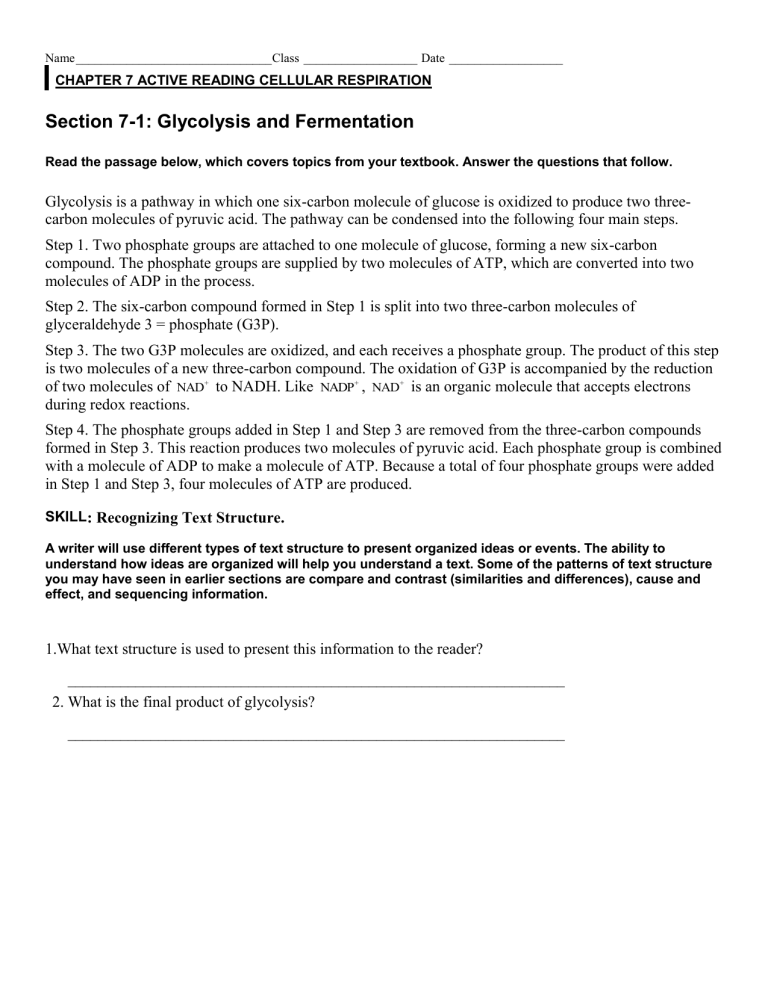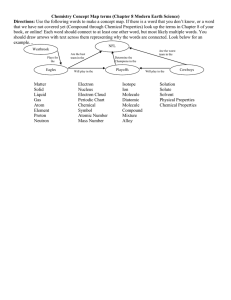
Name _______________________________Class __________________ Date __________________ CHAPTER 7 ACTIVE READING CELLULAR RESPIRATION Section 7-1: Glycolysis and Fermentation Read the passage below, which covers topics from your textbook. Answer the questions that follow. Glycolysis is a pathway in which one six-carbon molecule of glucose is oxidized to produce two threecarbon molecules of pyruvic acid. The pathway can be condensed into the following four main steps. Step 1. Two phosphate groups are attached to one molecule of glucose, forming a new six-carbon compound. The phosphate groups are supplied by two molecules of ATP, which are converted into two molecules of ADP in the process. Step 2. The six-carbon compound formed in Step 1 is split into two three-carbon molecules of glyceraldehyde 3 = phosphate (G3P). Step 3. The two G3P molecules are oxidized, and each receives a phosphate group. The product of this step is two molecules of a new three-carbon compound. The oxidation of G3P is accompanied by the reduction of two molecules of NAD+ to NADH. Like NADP+ , NAD+ is an organic molecule that accepts electrons during redox reactions. Step 4. The phosphate groups added in Step 1 and Step 3 are removed from the three-carbon compounds formed in Step 3. This reaction produces two molecules of pyruvic acid. Each phosphate group is combined with a molecule of ADP to make a molecule of ATP. Because a total of four phosphate groups were added in Step 1 and Step 3, four molecules of ATP are produced. SKILL: Recognizing Text Structure. A writer will use different types of text structure to present organized ideas or events. The ability to understand how ideas are organized will help you understand a text. Some of the patterns of text structure you may have seen in earlier sections are compare and contrast (similarities and differences), cause and effect, and sequencing information. 1.What text structure is used to present this information to the reader? __________________________________________________________________ 2. What is the final product of glycolysis? __________________________________________________________________ Name _______________________________Class __________________ Date __________________ 3.Insert the following labels on the diagram to show the steps of glycolysis: “4 ATP,” “2 ATP,” “2 molecules of 3-carbon compound,” “Glucose,” “2 molecules of pyruvic acid,” “6-carbon compound,” and “2 molecules of G3P.” Circle the letter of the phrase that best completes the statement. 4. NADP+ and NAD+ are similar in that both a. accept electrons during redox reactions. b. are types of organic molecules. c. are forms of pyruvic acid. d. Both (a) and (b) Name _______________________________Class __________________ Date __________________ Section 7-2: Aerobic Respiration Read the passage below, which covers topics from your textbook. Answer the questions that follow. The Krebs cycle has five main steps. In eukaryotic cells, all five steps occur in the mitochondrial matrix. Step 1. A two-carbon molecule of acetyl CoA combines with a four-carbon compound, oxaloacetic acid, to produce a six-carbon compound, citric acid. Step 2. Citric acid releases a CO2 molecule and a hydrogen atom to form a five-carbon compound. The electron in the hydrogen atom is transferred to NAD+, reducing it to NADH. Step 3. The five-carbon compound formed in Step 2 also re-leases a CO2 molecule and a hydrogen atom, forming a four-carbon compound. Again, NAD+ is reduced to NADH. In this step, a molecule of ATP is also synthesized from ADP. Step 4. The four-carbon compound formed in Step 3 releases a hydrogen atom to form another four-carbon compound. This time, the hydrogen atom is used to reduce FAD to FADH2. FAD, or flavin adenine dinucleotide, is a molecule very similar to NAD+. Like NAD+, FAD accepts electrons during redox reactions. Step 5. The four-carbon compound formed in Step 4 releases a hydrogen atom to regenerate oxaloacetic acid, which keeps the Krebs cycle operating. The electron in the hydrogen atom reduces NAD+ to NADH. Recall that in glycolysis one glucose molecule produces two pyruvic acid molecules, which can then form two molecules of acetyl CoA. Thus, one glucose molecule is completely broken down in two turns of the Krebs cycle. These two turns produce six NADH, two FADH2 two ATP, and four CO2 molecules. SKILL: Sequencing Information 1. Sequence the events to show the order in which they occur during the Krebs cycle. Write “1” on the line in front of the event that occurs first. Write “2” on the line in front of the event that occurs next, and so on. ______ a. Citric acid releases a CO2 molecule and a hydrogen atom to form a five-carbon compound. ______ b. A four-carbon compound is converted into oxaloacetic acid. ______ c. A five-carbon compound releases a CO2 molecule to form a four-carbon compound. ______ d. A molecule of acetyl CoA combines with oxaloacetic acid to produce citric acid. ______ e. A four-carbon compound releases a hydrogen atom to form another four-carbon compound. Name _______________________________Class __________________ Date __________________ 2. The figure below shows the Krebs cycle. Using the information contained in the passage, write the name of the compound at each lettered block on the lines below the figure. Use the following labels: “4carbon compound,” “5-carbon compound,” “Oxaloacetic acid,” and “Citric acid.” You will use a label more than once. a.___________________ b.___________________ c. ___________________ d.___________________ e.___________________ Circle the letter of the phrase that best completes the statement. 3. Two completions of the Krebs cycle produce six NADH, two FADH2, four CO2, and a. four glucose molecules. c. four ATP molecules. b. two ATP molecules. d. Both (a) and (b)


